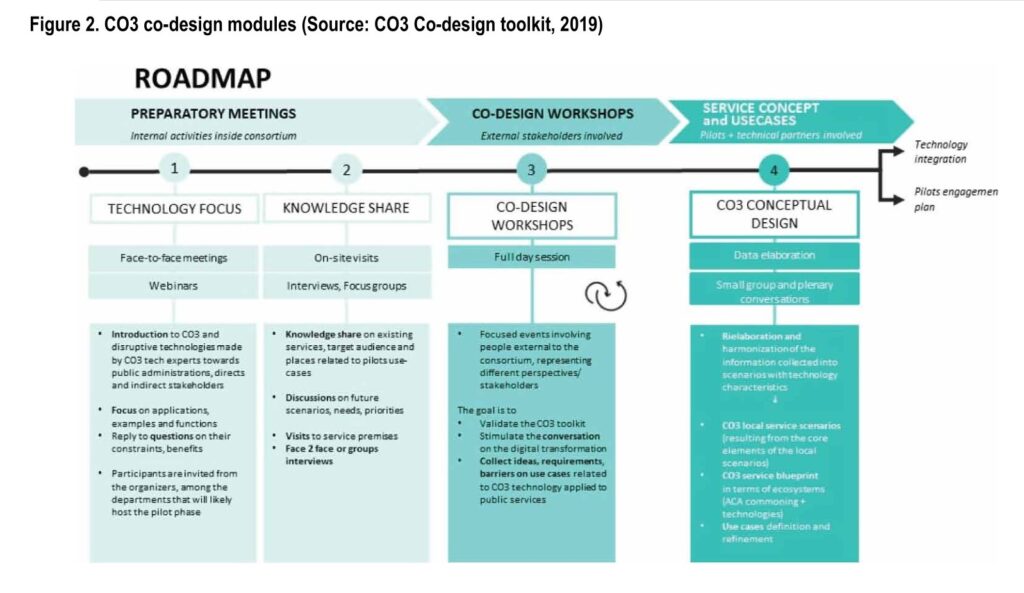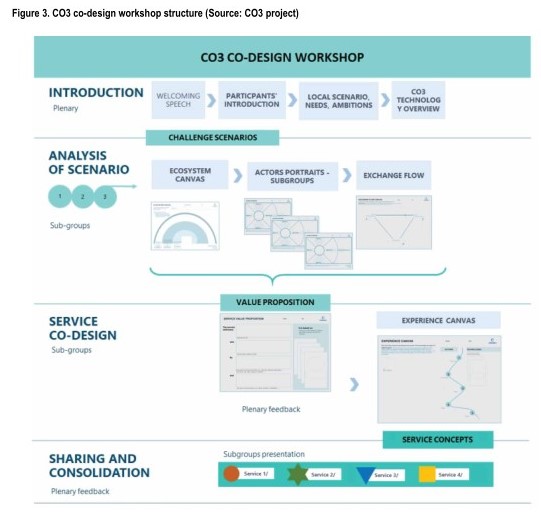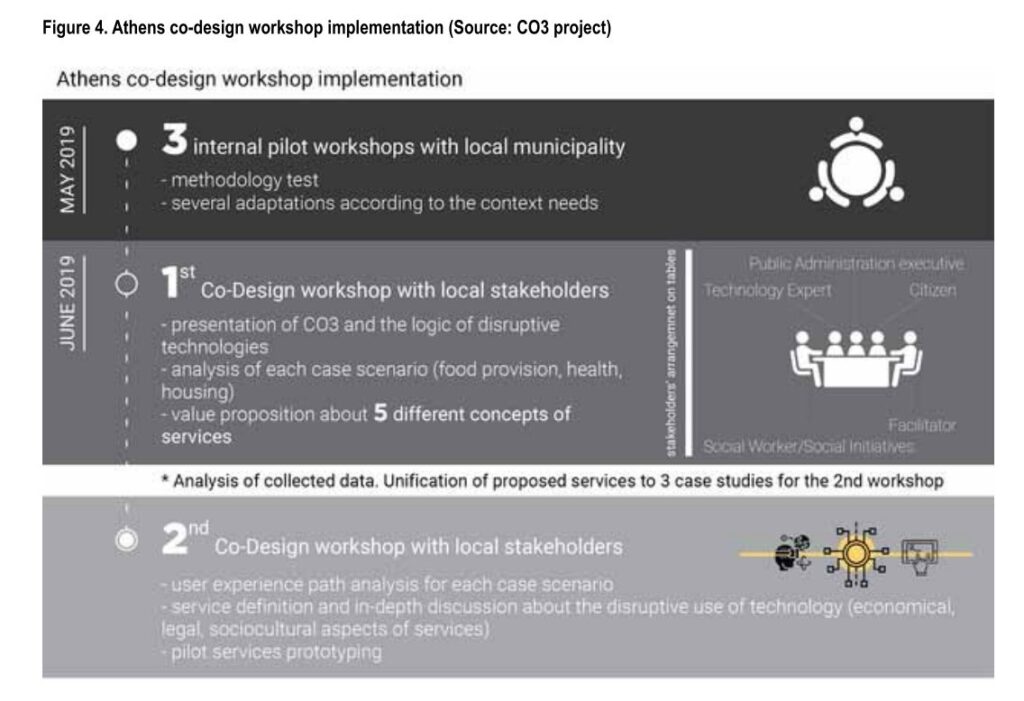The present file appears published for the first time in International Journal of Urban Planning and Smart Cities / Volume 2 • Issue 1 • January-June 2021 /
Elisa Pautasso, LINKS Foundation, Italy
Antonella Frisiello, LINKS Foundation, Italy
https://orcid.org/0000-0002-6600-0068
Mario Chiesa, LINKS Foundation, Italy
https://orcid.org/0000-0001-8719-380X
Enrico Ferro, LINKS Foundation, Italy
Fabrizio Dominici, LINKS Foundation, Italy
Gregory Tsardanidis, Open Lab Athens, Greece
Ioannis Efthymiou, Open Lab Athens, Greece
Giannis Zgeras, Open Lab Athens, Greece
Vasilis Vlachokyriakos, Open Lab Athens, Greece
Participatory design methods are becoming increasingly known, required, and applied in innovation projects. This article presents the experience gained in the H2020 projectCO3 “Digital Disruptive Technologies to Co-Create, Co-Produce, and Co-Manage OpenPublic Services Along With Citizens.”
It describes the participatory design-oriented approach to actively engage stakeholders in the definition of public services augmented by disruptive technologies in the area of urban commoning.
The implementation and the main results of the co-design workshops carried out in Athens, one of the three CO3pilots.
The Co-Design of Open Public Services (Phase 1: Service Ideation)
Methodology
The vision and the ambition of the CO3project entail the participatory approach to define both the implemented process and the expected results. In particular, in the CO3project the co-design has been assumed as a reference method to engage and involve several stakeholders in defining open services of co-creation and co-production including citizens and a renewed role of the PA. This objective has been addressed by a co-design approach aiming to:
- Create a connection between the project vision and the real contexts of application;
- Connect different stakeholders and their perspectives, creating a long-term engagement supporting all the project phases;
- Share knowledge and practises, including knowbetter the selected technologies.

The CO3 co-design workshops follow a four-step structure (Figure 3): the activity starts from the awareness phase, in which the participants introduce themselves and begin to know the common framework and disruptive technologies and accept the challenge. . Subsequently, the definition of the range of action aims to analyze the existing scenario and share knowledge about it. Two canvases developed within the Platform Design Toolkit (Cicero, 2016), the Ecosystem canvas and Portrait of the actor, have been adapted to the context of CO3. In particular, the ecosystem canvas has been personalized by including three unique entities: consumer-peers, producer-peers, and partners, with the specific indication of considering the PA in the same way as other actors. This change was introduced to stimulate participants to think about PA in an unconventional and more coherent way. common principles.

The Athens Case Study
Context of Athens: Athens, like all of Greece, has been hit hard by the economic crisis and the austerity policies that followed. Serious social problems arose as a consequence of this situation. A significant number of people lacked access to vital goods and services such as housing, food and State and local authorities were unable to respond adequately. In this environment, new solidarity initiatives emerged (Chrysostomou, 2015). They operate as social movements with the objective of challenging austerity policies politically and as collective structures that aim to meet the basic needs of the fighters. Social clinics, food distribution networks, solidarity schools, etc. participated in these actions. An extensive survey was conducted on these initiatives, which concluded by highlighting the significant potential of technologies to work meaningfully with these spaces of social innovation and design technologies that support civic action effectively and responsibly (Vlachokyriakosetal.,2017)
Implementation of the Co-Design Workshop: In response to these emerging difficulties, Athens has been chosen as a pilot to test the CO3 approach. Specifically, the city has fully implemented the CO3 methodology, following the process and adapting the visual facilitation tools and bringing various adaptations according to the specific needs of the context. The local municipality participated in the preparation and implementation of the co-design process through its information systems development company. acts of the municipality in terms of social services they have been deduced from the close relationship with the municipality. In addition, an extensive network of utility design experts and management, policy makers and technical partners has been activated to bring knowledge from the field into the co-design process. The process was as meaningful as possible for all the participants, the researchers tried to involve some of the solidarity initiatives (social clinics, network of markets without intermediaries, solidarity networks for housing and food distribution for refugees, cooperative housing initiatives) that were taking place in the city. Figure 4 shows the summary of the workshops that have been carried out in Athens in May 2019). These internal workshops were held to test the CO3 methodology internally and adapt to the specific context of Athens.

Lessons Learned
As previously stated, participation is one of the distinctive features of the project, indicated as a strategy to make the community concrete, allowing citizens to collaborate with each other and with the PA to co-create and co-produce new services. In line with this vision, co-design has been identified as a participatory approach to involve all stakeholders in the definition of novel solutions, capable of meeting the needs and desires of the real context local actors. Participation is not easy, but several advantages can be highlighted in the experience described. Specifically, both methodological and practical implications of the proposed approach can be deduced.
1.- Methodological
Careful planning of co-design methodology and techniques allows building knowledge, engagement and ideas that represent a plurality of perspectives through an active path. that works as an experience based on bilateral dialogue, conversations, exchanges and artifacts.
Co-design produces different types of results:
- From the perspective of researchers, organizers, moderators, it is an opportunity to learn and gain a situated understanding of the real context and access. skills and tacit knowledge of existing practices, procedures, beliefs, expectations and obstacles. This awareness is relevant: the ability to look at a solution from other perspectives and consider pragmatic factors helps to reinforce the quality of the proposed solutions;
- From the perspective of the participants, co-design offers novel forms of participation, allowing contact with local actors and PA in a more proactive and influential way. On the possibility of learning and discovering local initiatives of public interest, participants can directly experiment with design, culture and tools, in a collaborative dialogue with professionals. The right place to highlight needs and desires and influence future local scenarios.
2.- Practical
The main practical implications of the proposed approach refer to the commitment of citizens and the acquisition of the methodology by the moderators. As already noted, participatory design is a good way to engage citizens and PAs around a common challenge. However, participation is difficult: it requires a strong commitment from decision-makers and policy makers. This is crucial to engage people in projects hooked on the real context and needs and to create the ground for better acceptance of the innovation to be launched. In addition, training public officials and policy makers in the design and construction of a design-oriented culture is a precondition that can enable more consistent design activities that can be widely applied from ideation to the design and implementation of policies. Finally, co-design, as an empirical research method, produces qualitative results, dense with meaning: they come from the direct experience and collaborative reworking of very heterogeneous groups of people. Despite the fact that the co-design workshops provide socialized or negotiated content, they deliver an intermediate result that needs to be elaborated to become an operational input for reliable services, complying with the technological and legal requirements, ethical aspects, as well as supply and supply aspects. communication.

